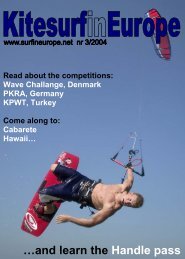Boards 2004 Trip to Isla de Coche New world speed record ...
Boards 2004 Trip to Isla de Coche New world speed record ...
Boards 2004 Trip to Isla de Coche New world speed record ...
- No tags were found...
Create successful ePaper yourself
Turn your PDF publications into a flip-book with our unique Google optimized e-Paper software.
Fortunately you don’t reallyneed <strong>to</strong> go out and by twodifferent sets of equipment, butcan use any combination of kiteand board for both of thetechniques, but there are somedifferences that are worth <strong>to</strong>mention. For the classical jumpswhere you use the kite <strong>to</strong> getlifted out of the water a kite witha high AR combined with anarrow board with lots of grip isthe optimal. To make a wakestyle jump the opposite ispreferred, a wi<strong>de</strong> board and akite with lower AR. The reason<strong>to</strong> use a lower AR is that theystay <strong>de</strong>eper down in the powerzone, whereas kites with highAR tends <strong>to</strong> stay very high up inthe window when rid<strong>de</strong>n. A kitewith high AR can thereforeeasily fly out of the power zonewhen you pop a jump. Howeverthere are some tricks <strong>to</strong> avoidthat this happens, but beforediscussing that we will take alook at the classical jumps.Classical jumpsA classical jump is illustrated inthe sequence below. The trick isas mentioned <strong>to</strong> redirect the kitein the opposite direction <strong>to</strong> theone you’re travelling and thenturn it back over your head oncethe board leaves the water. Theheight of the jump <strong>de</strong>pends onmany things, but the mainingredients are high <strong>speed</strong> andgood power in the kite. To boostup the height further theredirection has <strong>to</strong> be quick andpowerful. The main difficulty is<strong>to</strong> maintain the edge of theboard throughout the whole redirection.This can be simplifiedby starting the redirection withthe kite in a higher position, like60 <strong>de</strong>grees from the water.Once in the air there is not <strong>to</strong>omuch <strong>to</strong> think about exceptmaking sure that you get thekite back in front of you beforelanding. Try <strong>to</strong> land with theboard flat and with the bodyweight straight over the centreof the board. Then it is just <strong>to</strong>start edging again and pick up<strong>speed</strong> for the next jump.Wake style jumpsFinally we look at how <strong>to</strong> pull offsome powerful wake stylejumps. Once again, <strong>speed</strong> andpower are the main ingredients,but instead of the redirection ofthe kite it is a powerful pop thatturns those in<strong>to</strong> a high jump.One of the concerns is, asmentioned, <strong>to</strong> avoid that the kitelooses the power when the jumpis initiated. The trick <strong>to</strong> avoidthis is <strong>to</strong> get the kite furtherdown in the power zone. Thiscan be achieved by slowlyturning the kite up and thenback down in the same time asyou fall off a little with the board<strong>to</strong> avoid getting lifted. The jumpis then initiated with a short andpowerful pop while the kite ismaintained low. In or<strong>de</strong>r <strong>to</strong> notmove the kite during the jump itcan be good <strong>to</strong> keep the handsclose <strong>to</strong> the centre of the bar,and don’t forget that a real wakeboard move is performedunhooked from the chickenloop!17





